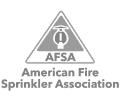Halon Alternatives for Fire Protection
If you have a room or area in your property which could receive more damage than it is worth from the water released by a sprinkler system in the event of a fire, you likely have a fire suppression system installed. Fire suppression systems use waterless agents to extinguish a fire quickly and with minimal damage to the assets, equipment, or machines within a room.
In the past, Halon was the chemical of choice for these fire suppression systems, and while it works well, it’s also been discovered that the chemical is dangerous to the environment and ozone. Halon systems are in the process of being decommissioned. While currently installed Halon systems do not need to be replaced, professional fire protection companies are only allowed to service the systems. For new installation, you will need to install an alternative to a Halon system—including our preferred system, FM-200 fire suppression system.
Alternatives to Halon Fire Suppression Systems
The fire suppression industry has worked to quickly produce a number of more environmentally friendly agents that are less harmful to the ozone layer and less likely to cause damage based on instability and likelihood of injury to individuals. Some examples of newly approved agents to be used in commercial buildings include:
- Carbon-based agents (such as Perfluorohexane)
- Carbon dioxide
- FM-200 (Heptafluoropropane)
Such agents are powders or foams that are based on a process of heat absorption, which helps protect areas with sensitive materials that could be destroyed by water just as easily as by fire. Such areas of your building could include:
- Filing & documents
- Archives
- Server rooms
- Rooms with valuable electronic
- Military operations
- Oil and gas production facilities
- Data centers
- And more
These alternatives are also environmentally approved and less of a danger chemically to anyone in the area.
Benefits of FM-200 Systems
Other positives of installing an FM-200 fire suppression system is that it doesn’t leave a residue once the fire is suppressed—meaning little to no cleanup is necessary after a discharge. This can also make a big difference in the effects of a fire, considering that one of the biggest expenses related to fires is cleanup and restoration.
Most consultants agree that the best of these Halon system alternatives is the FM-200 system, manufactured by several different companies. This clean agent is quite popular with building managers and significantly reduces risk of damage to important internal facilities that could otherwise be destroyed.
Replacing a Halon System
One major concern of replacing Halon fire suppression systems is that the systems cannot be infused with the new agents. The piping and other elements of the system have to be modified or replaced for any and all of the new agents to function. Other issues arise with the fact that Halon systems tend to be highly compressed, and removal of the old system requires specialized handling, careful containment, and a guarantee that the canisters are not damaged, as leaks are dangerous and explosions of the agent possible.
Should you decide to have your fire suppression system replaced because it is still employing Halon, you should consult an experienced fire protection company well-versed in the use of fire suppression systems in commercial environments. Kauffman Co. is just that and has served the Houston area for many years.
With our licensed fire protection technicians, you’ll get the advice you need in choosing your new system and the clean agent that is right for your application, as well as guaranteed safe and careful removal of the existing system.
Eventually, you’ll want to replace your Halon system with something more environmentally and health friendly. However, take the time to research your options, and don’t rush into anything without consulting experts in the fire suppression industry.















